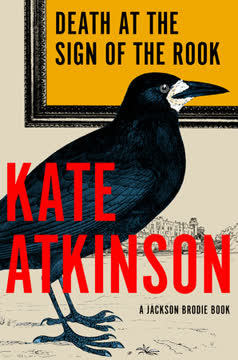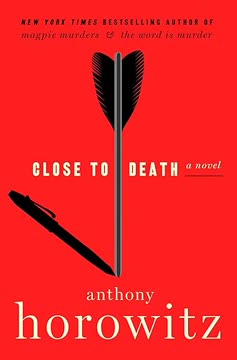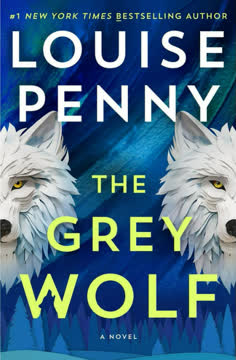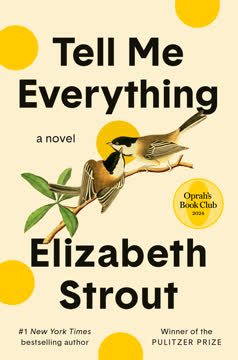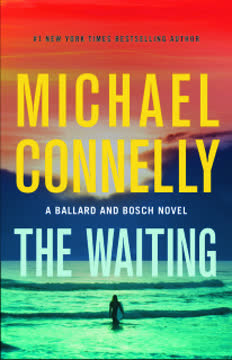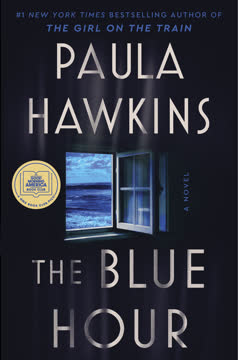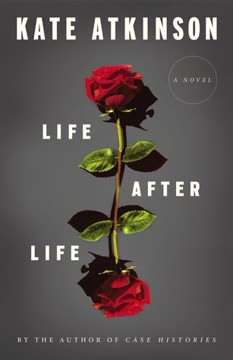Plot Summary
Invitation to Rook Hall
A group of guests, actors, and staff gather at Rook Hall, a stately home now operating as a country house hotel, for a murder mystery weekend. The event is set up as a playful, immersive whodunit, but beneath the surface, the house and its inhabitants are beset by real secrets, financial decline, and the ghosts of the past. The Miltons, the aristocratic family who own the estate, are struggling to maintain their legacy amid modern pressures, and the event is as much about survival as entertainment. The guests, including the brooding ex-detective Jackson Brodie, are drawn into a web of intrigue that blurs the line between performance and reality.
The Disappearing Carer
Jackson Brodie is hired by the Padgett twins, Hazel and Ian, after their elderly mother Dorothy dies and her live-in carer, Melanie Hope, disappears—along with a small Renaissance portrait known as "Woman with a Weasel." The painting, of unknown provenance and value, was Dorothy's prized possession. Melanie, who had seemed trustworthy and unremarkable, leaves no trace: her address is false, her phone is a burner, and her background is a blank. The twins are reluctant to involve the police, claiming they want to avoid trouble for Melanie, but their story is riddled with inconsistencies. Jackson's investigation quickly reveals that nothing about the theft—or the family—is as simple as it seems.
Portrait of a Weasel
The missing painting becomes the focal point of the mystery. It depicts a young woman with a small animal—possibly a weasel, stoat, or pine marten—on her lap. The painting's origins are murky: the Padgetts claim their father bought it at a postwar auction, but records suggest the auction never happened due to a fire. The painting's style hints at a lost Renaissance masterpiece, possibly by Raphael, but without provenance, it is unsellable on the open market. Jackson's research into art theft, lost masterpieces, and the symbolism of animals in portraiture deepens the enigma, as does his growing suspicion that the painting's history is entwined with secrets the Padgetts would rather keep buried.
The Padgett Siblings' Secret
Hazel and Ian's relationship is fraught with rivalry and mistrust. As Jackson probes, he discovers that Dorothy added a late codicil to her will, witnessed by a neighbor and a mysterious "Hannah." The codicil's contents are unknown, but it threatens to upend the siblings' expected inheritance. The twins' eagerness to find Melanie and the painting is less about sentiment and more about control over the estate. Their evasiveness and the speed with which they move to sell Dorothy's house suggest ulterior motives. The missing painting, the codicil, and the family's history of quiet resentments converge, hinting at a deeper betrayal.
The House of Decline
Burton Makepeace, the Miltons' ancestral home, is a microcosm of fading English aristocracy. Lady Milton, her children Piers, Arabella, and Cosmo, and a cast of eccentric staff struggle to keep the estate afloat. The house is filled with unsold treasures, empty rooms, and the weight of history. Financial pressures force the family to open the house to the public, sell off art, and convert wings into a hotel. The family's internal dynamics—resentment, secrets, and the burden of legacy—mirror the broader themes of loss and adaptation. The theft of a Turner painting by a trusted housekeeper, Sophie Greenway, two years earlier still haunts them.
The Vicar's Crisis
Simon Cate, the local vicar, is a man in crisis. Once touched by a fleeting moment of religious revelation, he now finds himself an atheist in a collar, going through the motions for his dwindling flock. After a parishioner's prayer, Simon loses his voice—psychosomatic aphonia, the doctors say. His muteness becomes a metaphor for his spiritual emptiness and inability to communicate his grief, especially over the loss of his infant son years before. Simon's journey through the snow, his encounters with the villagers, and his eventual heart attack during the murder mystery weekend parallel the novel's themes of loss, redemption, and the search for meaning.
The Soldier's Wound
Ben Jennings, a former Army major who lost his leg in Afghanistan, is convalescing at his sister Fran's smallholding near Burton Makepeace. Haunted by PTSD, depression, and a sense of purposelessness, Ben is drawn into the events at the house. His outsider's perspective, physical vulnerability, and unexpected heroism during the crisis on the snowbound estate provide a counterpoint to the aristocratic drama. Ben's journey is one of reluctant engagement with life, culminating in acts of courage that help resolve the story's central conflicts.
Art, Theft, and Provenance
Jackson's investigation into the missing painting leads him into the shadowy world of art theft, forgery, and the black market. He learns that most stolen art is used as criminal currency, rarely recovered, and often hidden in freeports or private collections. The Turner stolen from Burton Makepeace, the Rembrandt from Mount Fernie, and the Padgetts' portrait all share a pattern: inside jobs, trusted staff, and a woman who moves from identity to identity—Melanie Hope, Sophie Greenway, Tilda, Beatrice. The question of provenance—proof of ownership—becomes both a legal and existential dilemma, as the true story of the painting's origins is gradually revealed.
The Will and the Codicil
The codicil to Dorothy Padgett's will, witnessed by her neighbor and "Hannah," is the key to the mystery. It leaves the house and savings to her granddaughter Alice, and the painting to Melanie Hope. The twins' frantic search for the codicil and their attempts to control the narrative expose their greed and duplicity. The painting's true history—stolen by Dorothy herself from a burning house, with her husband's possible complicity—emerges through a hidden story, burned with Dorothy's body. The codicil is both a literal and symbolic act of justice, rewarding loyalty and punishing neglect.
The Murder Mystery Weekend
As the snowstorm intensifies, the murder mystery weekend at Rook Hall becomes a surreal echo of the real mysteries unfolding in the house. The actors, guests, and family members are trapped together, their roles blurring as actual danger intrudes. The performance, based on a recycled plot from a forgotten crime novelist, devolves into chaos as the line between play-acting and genuine peril vanishes. The house's labyrinthine layout, secret passages, and history of real and fictional deaths create a claustrophobic atmosphere where trust is in short supply and everyone is a suspect.
The Storm and the Siege
A blizzard cuts off the estate from the outside world. Guests, staff, and family are marooned, and the house's decaying grandeur becomes a prison. The storm is both literal and metaphorical, forcing characters to confront their secrets, fears, and desires. The arrival of an escaped killer, Carl Carter, raises the stakes from drawing-room drama to life-and-death struggle. The storm exposes the fragility of the social order, the limits of civility, and the resilience (or lack thereof) of the characters.
The Real and the Fake
The theme of authenticity—of art, of people, of stories—runs through the novel. The Turner stolen from Burton Makepeace is revealed to be a fake; the real one may have been sold or lost. The missing portrait's provenance is fabricated, its true story hidden in a burned confession. Melanie Hope/Sophie Greenway/Beatrice is a master of disguise, moving through lives and crimes with ease. The murder mystery itself is a parody of detection, while the real mysteries—of love, loyalty, and justice—are harder to solve. The characters' performances, both on and off stage, reveal the masks they wear to survive.
The Escaped Killer
Carl Carter, a notorious cop-killer, escapes from prison and makes his way to the snowbound estate. His presence turns the playful murder mystery into a genuine siege. Carter's violence, unpredictability, and desperation force the characters to confront real danger. Ben, Reggie (a young detective), and Jackson are drawn into a deadly game of cat and mouse, culminating in a rooftop confrontation. The intrusion of real violence into the world of make-believe exposes the limits of fantasy and the necessity of courage.
The Final Confrontation
The climax unfolds in a series of confrontations: Carter is pursued through the house and onto the roof, where Ben and Reggie risk their lives to stop him. Jackson, cornered by Carter, is saved by Beatrice, who shoots the killer and then vanishes. The police arrive, led by DCS Louise Monroe, to find the crisis resolved but the true culprits—of art theft and deception—gone. The aftermath is a tangle of heroism, trauma, and unanswered questions, as the survivors reckon with what they have lost and what they have learned.
The Woman with Many Names
Beatrice, the woman of many aliases, finally reveals herself to Jackson. She confesses to the thefts, explains the true history of the painting, and justifies her actions as both justice and artistry. She claims the painting as her own, by right of Dorothy's codicil and her own cunning. Her escape, aided by Alice Smithson and a complicit neighbor, is both a triumph and a question mark: is she a villain, a hero, or something in between? Her ability to slip through the cracks of law and identity is both unsettling and oddly liberating.
Restoration and Aftermath
In the aftermath, the estate begins to recover: the snow melts, the dead are buried, and the survivors find new purpose. Ben and Reggie, united by their ordeal, begin a tentative romance. Simon Cate, revived from his heart attack, contemplates a quieter, more honest life. The Miltons, battered but unbowed, continue their struggle to adapt. The painting's fate remains uncertain, its value as much in its story as its artistry. Justice is imperfect, but some measure of restoration is achieved.
The Curtain Falls
The novel ends with a sense of closure but not finality. The characters, changed by their experiences, move forward—some to new lives, some to old patterns. The mysteries, both solved and unsolved, become part of the house's legend. The performance is over, but the play of life continues. The final image is of a clean, well-lighted place: a café, a conversation, a sense that, despite everything, hope endures.
Characters
Jackson Brodie
Jackson is a former police inspector turned private investigator, marked by personal loss and a deep sense of justice. He is both world-weary and dogged, drawn to cases that echo his own unresolved grief. His relationships—with his children, ex-wife, and the women he encounters—are fraught with longing and regret. Jackson's investigation into the missing painting and the vanished carer is as much about understanding himself as solving the case. He is skeptical, compassionate, and often frustrated by the limits of law and the messiness of life. His development is a journey from detachment to engagement, as he risks his safety and heart to protect others.
Reggie Chase
Reggie is a police officer with a sharp mind, a love of facts, and a deep well of empathy. Orphaned young, she is driven by a need for order and justice, but also by a longing for family and belonging. Her partnership with Jackson is both professional and personal, marked by mutual respect and occasional exasperation. Reggie's courage and resourcefulness are tested during the siege at Burton Makepeace, where she faces real danger and finds unexpected love with Ben. Her psychological journey is one of overcoming fear, embracing vulnerability, and claiming her place in the world.
Ben Jennings
Ben is a former Army major struggling with the loss of his leg, PTSD, and a sense of purposelessness. His convalescence at his sister's smallholding is both a retreat and a slow reawakening. Drawn into the events at Burton Makepeace, Ben's courage and decency come to the fore. His relationship with Reggie offers hope and healing, while his actions during the crisis demonstrate that heroism is not the absence of fear but the willingness to act despite it. Ben's development is a testament to resilience, kindness, and the possibility of renewal.
Lady Honoria Milton
Lady Milton is the embodiment of fading English aristocracy: proud, witty, and acutely aware of her family's decline. She navigates the challenges of financial ruin, family dysfunction, and the intrusion of modernity with a mix of stoicism and nostalgia. Her relationships—with her children, staff, and the house itself—are complex, marked by both affection and disappointment. Lady Milton's psychological depth lies in her ability to adapt, mourn, and find moments of joy amid loss.
Simon Cate
Simon is a priest who has lost his faith and, symbolically, his voice. His journey through the novel is one of grappling with grief, guilt, and the search for authenticity. His relationships—with his late wife, lost son, and the villagers—are tinged with regret and longing. Simon's heart attack and subsequent recovery force him to confront his mortality and the possibility of redemption. His psychological arc is one of acceptance, humility, and the quiet heroism of endurance.
Hazel and Ian Padgett
Hazel and Ian are the adult children of Dorothy Padgett, locked in a lifelong rivalry over inheritance, affection, and control. Their outward civility masks deep-seated resentments and a willingness to bend the truth. Their handling of their mother's death, the missing painting, and the codicil reveals their self-interest and capacity for self-deception. Psychologically, they are studies in denial, projection, and the corrosive effects of unresolved family conflict.
Melanie Hope / Sophie Greenway / Beatrice
The woman at the heart of the mystery is a consummate actress, moving from identity to identity—carer, housekeeper, waitress, thief. Her motivations are complex: part justice, part artistry, part survival. She is both kind and ruthless, capable of genuine affection and calculated deception. Her psychological depth lies in her ability to adapt, her enjoyment of the game, and her ambiguous morality. She is both a villain and a liberator, challenging the boundaries of law, loyalty, and selfhood.
Alice Smithson
Alice is Dorothy's granddaughter, trapped in an abusive marriage and overlooked by her family. Her alliance with Beatrice is an act of self-preservation and rebellion. She is both victim and agent, complicit in the theft and escape. Her psychological journey is one of awakening, courage, and the pursuit of freedom.
Piers, Cosmo, and the Miltons
The Milton family—Piers, Cosmo, Arabella, and their children—are a gallery of English eccentricity, struggling to maintain their status and identity in a changing world. Their relationships are marked by rivalry, disappointment, and moments of genuine affection. Psychologically, they represent the tension between tradition and adaptation, pride and vulnerability.
Carl Carter
Carter is the novel's most overt villain: violent, unpredictable, and a catalyst for crisis. His intrusion into the snowbound estate forces the characters to confront real danger and their own capacity for courage or cowardice. Psychologically, he is a force of entropy, exposing the fragility of order and the necessity of moral choice.
Plot Devices
Nested Mysteries and Metafiction
The novel uses the device of a murder mystery weekend—complete with actors, scripts, and audience participation—as a frame for the real mysteries unfolding in the house. The interplay between performance and reality, the recycling of old plots, and the self-conscious references to detective fiction create a metafictional layer that both satirizes and pays homage to the genre. The nested structure allows for commentary on the nature of storytelling, the unreliability of perception, and the ways in which people perform roles in their own lives.
Shifting Perspectives and Ensemble Cast
The narrative moves fluidly among a large cast of characters, each with their own secrets, motivations, and psychological wounds. This ensemble approach allows for a rich exploration of interconnected lives, the subjectivity of truth, and the ways in which individual stories overlap and collide. The shifting perspectives create suspense, empathy, and a sense of the complexity of human experience.
Foreshadowing and Red Herrings
The novel is replete with foreshadowing—hints about the painting's origins, the true nature of the carer, the significance of the codicil, and the impending storm. Red herrings abound: false leads, unreliable narrators, and the deliberate confusion between performance and reality. The delayed revelation of key facts—such as the painting's theft by Dorothy, the codicil's contents, and Beatrice's true identity—maintains suspense and rewards attentive reading.
Symbolism and Thematic Echoes
The missing painting, the decaying house, the snowstorm, and the murder mystery itself are all symbols of larger themes: the fragility of legacy, the persistence of beauty, the inevitability of loss, and the human need for connection and justice. The repetition of motifs—lost art, burned confessions, shifting identities—creates a tapestry of meaning that resonates beyond the plot.
Analysis
"Death at the Sign of the Rook" is both a playful homage to the classic country house mystery and a profound exploration of the ways in which people construct, conceal, and reveal their identities. Through its intricate plot, ensemble cast, and metafictional devices, the novel interrogates the boundaries between truth and fiction, justice and revenge, performance and authenticity. At its heart, it is a story about the persistence of beauty and hope amid decline and chaos: the lost painting, the battered house, the wounded characters all testify to the enduring human need for meaning, connection, and restoration. The lessons are clear: the past is never truly past, justice is rarely perfect, and the stories we inherit and invent shape who we become. In the end, the curtain falls, but the play of life goes on—messy, unresolved, and full of possibility.
Last updated:
FAQ
Synopsis & Basic Details
What is Death at the Sign of the Rook about?
- A Layered Mystery Unfolds: The novel weaves together two primary investigations: private detective Jackson Brodie's search for a missing Renaissance portrait and its vanished carer, Melanie Hope, and the unfolding chaos of a murder mystery weekend at the snowbound Burton Makepeace House, where a real killer, Carl Carter, is on the loose.
- Intertwined Fates & Secrets: As a blizzard traps guests and staff, including a doubting vicar, a wounded veteran, and a sharp young detective, their personal histories, hidden motivations, and long-held secrets begin to surface, blurring the lines between the staged whodunit and genuine peril.
- Exploration of Identity & Art: At its core, the story delves into themes of authenticity, loss, and the stories people tell themselves and others, using stolen art and shifting identities as metaphors for the characters' complex inner lives and the decaying grandeur of the English aristocracy.
Why should I read Death at the Sign of the Rook?
- Masterful Interweaving Narratives: Kate Atkinson expertly juggles multiple storylines and a large ensemble cast, creating a rich, complex tapestry that keeps readers engaged with its intricate plot twists and unexpected connections.
- Deep Psychological & Thematic Resonance: Beyond the compelling mystery, the novel offers profound insights into human nature, grief, trauma, and the search for meaning, making it a thought-provoking read that lingers long after the final page.
- Signature Atkinson Wit & Style: Fans of Kate Atkinson will delight in her distinctive narrative voice, characterized by sharp wit, literary allusions, and a unique blend of dark humor and poignant observation, making for a truly immersive reading experience.
What is the background of Death at the Sign of the Rook?
- Post-War English Decline: The novel is set against a backdrop of fading English aristocracy and post-war societal shifts, where grand stately homes like Burton Makepeace struggle for survival, forced to adapt to commercialism and modern pressures, reflecting a broader national identity crisis.
- The Art World's Underbelly: It delves into the murky world of art theft and provenance, highlighting how valuable artworks can become underworld currency or be hidden away, reflecting the illicit trade and the often-unseen histories behind famous pieces.
- Intertextual & Genre Play: Atkinson playfully engages with the conventions of the "cosy crime" genre, particularly referencing Nancy Styles novels, while simultaneously subverting them with real-world violence and psychological depth, creating a meta-narrative that comments on storytelling itself.
What are the most memorable quotes in Death at the Sign of the Rook?
- "The guilty always masquerade as the innocent but it is rarely the other way round.": This epigraph, attributed to Nancy Styles, perfectly encapsulates the novel's central theme of deception and hidden truths, challenging the reader to question appearances and motivations throughout the story.
- "The past is a foreign country.": Uttered by Sophie Greenway (Beatrice) to Lady Milton, this quote, an allusion to L.P. Hartley's The Go-Between, highlights the novel's preoccupation with memory, history, and the often-unbridgeable gap between different eras and personal experiences.
- "Ars longa, vita brevis.": Repeated by Jackson Brodie, this Latin phrase ("Art is long, life is short") serves as a recurring motif, underscoring the enduring power of art and stories in contrast to the fleeting nature of human life, a theme central to the mystery of the "Woman with a Weasel" painting.
What writing style, narrative choices, and literary techniques does Kate Atkinson use?
- Non-Linear & Fragmented Narrative: Atkinson employs a non-chronological, often fragmented narrative structure, jumping between characters' perspectives and timelines, which mirrors the fractured memories and hidden histories of the characters and the mysteries they inhabit.
- Rich Intertextuality & Allusion: The text is dense with literary allusions, from Jane Austen and Shakespeare to Hemingway and nursery rhymes, enriching the narrative with layers of meaning and inviting readers to engage with the story on multiple intellectual levels.
- Metafiction & Self-Awareness: The novel frequently breaks the fourth wall, commenting on its own narrative devices (e.g., "clue alert!", "logical fallacy"), and uses the "murder mystery weekend" as a metafictional frame, blurring the lines between the story being told and the act of storytelling itself.
Hidden Details & Subtle Connections
What are some minor details that add significant meaning?
- The "Red Herrings" Chapter Title: The very first chapter title, "Red Herrings," immediately signals the novel's playful yet deliberate use of misdirection, preparing the reader for false leads and unreliable narratives, a core element of the mystery genre that Atkinson both embraces and subverts.
- Dorothy Padgett's Spectacles: The recurring mention of Dorothy's thick-lensed spectacles, neatly folded on her bedside table, subtly emphasizes her vulnerability and dependence, and later, their absence in her coffin, despite Jackson's expectation, highlights the meticulousness of Beatrice's actions and Dorothy's desire for a "perfect" afterlife.
- The Unplayed Bechstein Piano: The Bechstein piano "shoehorned" into Lady Milton's sitting room, unplayed since Sophie left, symbolizes the loss of joy and cultural refinement in Burton Makepeace, directly linking Sophie's departure to the house's emotional and aesthetic decline.
What are some subtle foreshadowing and callbacks?
- Lady Milton's "Unspeakable" Memory: Lady Milton's childhood memory of walking in on her mother "doing something unspeakable with one of the grooms" subtly foreshadows the later revelation of her own affair with Pip, the art valuer, and the questionable paternity of Cosmo, hinting at a pattern of aristocratic indiscretion.
- Simon Cate's Lost Voice: Simon's psychosomatic aphonia, which he initially attributes to a spiritual crisis, is subtly foreshadowed by his earlier self-confession of "vicar-speak" – filling "spaces where the spirit should be with extenuated grammar and endless conditionals," suggesting a long-standing inability to speak his truth.
- The "Big Bag" Motif: Hazel Padgett's repeated emphasis on Melanie Hope's "big bag" initially serves as a red herring for the painting's theft, but later callbacks to it (e.g., Melanie "could just have unhooked the painting... and slipped it in that bag") subtly reinforce Beatrice's calculated planning and her ability to conceal her true intentions in plain sight.
What are some unexpected character connections?
- Dorothy Padgett and Harold's Dark Secret: The revelation that Dorothy herself stole the "Woman with a Weasel" painting, and Harold's possible complicity in burning Ottershall House to cover the theft, unexpectedly links the seemingly mundane Padgett family to a significant art crime, challenging their "pillar of the community" facade.
- Lady Milton's Connection to the Vicar's Family: The detail that Sophie Greenway (Beatrice) is a "vicar's daughter" and that Simon Cate's wife, Rosalind, was also a vicar's daughter, creates a subtle, almost familial, connection between Lady Milton's household and Simon's world, highlighting shared experiences of loss and disillusionment across social strata.
- Ben Jennings and Simon Cate's Parallel Trauma: The unexpected bond between Ben, the physically wounded soldier, and Simon, the spiritually wounded vicar, is forged through their shared experiences of profound loss (Ben's leg, Simon's son) and near-death experiences, creating a poignant parallel in their journeys toward healing and acceptance.
Who are the most significant supporting characters?
- Bob Gordon, the Trusting Neighbor: Bob Gordon, Dorothy Padgett's elderly Scottish neighbor, initially appears as a minor character, but his trusting nature and casual revelations about the codicil and his grandson's photograph of the painting prove crucial to Jackson's investigation, acting as an unwitting catalyst for uncovering the truth.
- Moira Jessop, the Unflappable Undertaker: Moira Jessop, the funeral director, provides a darkly humorous and surprisingly insightful counterpoint to the characters' anxieties about death. Her professional detachment and matter-of-fact observations (e.g., "I do the ladies' nails") inadvertently provide Reggie with key details about Alice Smithson's visit to the funeral home.
- Tilda, the Agency Waitress (Beatrice's Alias): Tilda, the temporary waitress at Burton Makepeace, is a fleeting but significant alias for Beatrice. Her brief, almost flirtatious interactions with Ben and her casual efficiency subtly hint at her true identity and her comfort in various roles, showcasing her mastery of disguise.
Psychological, Emotional, & Relational Analysis
What are some unspoken motivations of the characters?
- Dorothy Padgett's Quiet Rebellion: Beyond the stated "sentimental value," Dorothy's decision to steal the painting and keep it hidden for decades, then bequeath it to Melanie/Beatrice and Alice, reveals a deep-seated, unspoken rebellion against her "bully" husband Harold and a desire to exert control over her legacy and offer justice from beyond the grave.
- Lady Milton's Search for Connection: Despite her aristocratic detachment, Lady Milton's unusual fondness for Sophie and her later grief over Sophie's disappearance (more than Johnny's death) hints at a profound, unspoken loneliness and a yearning for genuine companionship that her own family fails to provide.
- Ian and Hazel's Performance of Grief: The Padgett twins' "leaden" acting and "shared script" during Jackson's initial interview reveal their unspoken motivation to control the narrative and conceal the painting's true, illicit provenance, prioritizing financial gain and reputation over genuine mourning or truth.
What psychological complexities do the characters exhibit?
- Simon Cate's Existential Apathy: Simon's loss of faith and subsequent aphonia are not merely physical ailments but manifestations of profound existential despair and unresolved grief over his son's death, leading to a complex internal struggle between his public role and private nihilism.
- Ben Jennings's Stoic Self-Punishment: Ben's refusal to fully engage with his PTSD and his tendency to "wallow" in melancholic self-pity, despite his physical recovery, reveal a complex psychological landscape where he unconsciously punishes himself for surviving and for the perceived failures in his personal life.
- Beatrice's Sociopathic Charm & Control: Beatrice's ability to seamlessly shift identities and her enjoyment of "the game" of deception, coupled with her genuine kindness towards Dorothy and Lady Milton, showcase a complex sociopathic charm that allows her to manipulate situations while maintaining a veneer of empathy, driven by a desire for control and artistic justice.
What are the major emotional turning points?
- Simon's Loss of Voice: Simon's sudden inability to speak after Beryl Sillitoe's prayer is a pivotal emotional turning point, forcing him to confront his spiritual emptiness and the chasm between his outward persona and inner turmoil, leading to a deeper, albeit silent, self-reflection.
- Ben's Encounter with Holly: Ben's decision to pick up the shivering spaniel, Holly, and tuck her into his parka during the blizzard marks a significant emotional shift, moving him from self-absorption and despair to a renewed sense of purpose and compassion, symbolizing his re-engagement with life.
- Alice Smithson's Flinch: Alice's flinch when her husband Mark throws his jacket at her, revealing her "bleak, helpless expression of the abused," is a stark emotional turning point that exposes the hidden domestic violence in her life, transforming her from a seemingly nervous character into a victim seeking escape.
How do relationship dynamics evolve?
- Jackson and Reggie's Unconventional Partnership: Their relationship evolves from initial professional antagonism and Jackson's attempts to "use" Reggie's police resources to a grudging respect and a nascent, unspoken bond, culminating in Reggie's protective "I'm her dad" lie and Jackson's genuine concern for her safety.
- Lady Milton and Sophie's Surrogate Daughter Bond: Lady Milton's relationship with Sophie transcends that of employer and employee, developing into a quasi-mother-daughter dynamic, evident in Lady Milton's deep sense of betrayal and loss after Sophie's disappearance, highlighting her emotional vulnerability.
- The Padgett Twins' Performative Harmony: Ian and Hazel's relationship, initially presented as a bickering but united front, devolves into open suspicion and recrimination as their shared "script" unravels, revealing the deep-seated resentments and competitive nature of their sibling bond, particularly concerning their inheritance.
Interpretation & Debate
Which parts of the story remain ambiguous or open-ended?
- The Fate of the Real Turner: While Beatrice claims the Turner she stole was a fake, the novel leaves the ultimate fate of the original Turner painting ambiguous. It's unclear if it was genuinely lost, sold illicitly by Piers, or if Beatrice's claim of it being a fake is another layer of her deception, leaving its true whereabouts and value open to interpretation.
- Beatrice's Ultimate Motivations: Despite her "confession" to Jackson, Beatrice's full motivations remain somewhat elusive. Is she a true "art lover" seeking to right wrongs, a "charming sociopath" who enjoys the game, or a complex blend of both? Her final escape with Alice leaves her moral alignment open to debate.
- The Future of Burton Makepeace: The novel concludes with the Miltons still struggling to maintain their estate, now a "Rook Hall" hotel. While the immediate crisis is over, the long-term viability of the house and the family's ability to truly adapt or simply continue their "painfully slow decline" remains an open question.
What are some debatable, controversial scenes or moments in Death at the Sign of the Rook?
- Jackson's "Autopsy" of Dorothy Padgett: Jackson's decision to visit Dorothy's corpse in the funeral home and attempt to take hair samples and fingernail scrapings is highly debatable. It crosses ethical and legal boundaries, raising questions about his methods and the extent to which a "good cause" justifies such intrusive actions.
- Beatrice's Act of "Justice": Beatrice's shooting of Carl Carter, while saving Jackson's life, is a controversial act of vigilante justice. It sparks debate about whether her actions are justifiable given Carter's dangerous nature, or if they simply reinforce a cycle of lawlessness, especially coming from a character who is herself a thief.
- The Miltons' Moral Compromises: The Milton family's casual acceptance of selling off family treasures, Piers's complicity in the Turner theft, and Cosmo's illicit dealings, present a controversial portrayal of the aristocracy. It invites readers to debate the extent of their moral decay and whether their "reduced circumstances" excuse their questionable ethics.
Death at the Sign of the Rook Ending Explained: How It Ends & What It Means
- The Resolution of the Immediate Threat: The novel culminates with the capture and death of Carl Carter, the escaped killer, primarily through the combined efforts of Ben Jennings and Reggie Chase, with Beatrice delivering the fatal shot. This resolves the immediate physical danger to the characters trapped in Burton Makepeace.
- Beatrice's Elusive Justice & Escape: Beatrice, the "woman with many names," reveals her true identity and motivations to Jackson, explaining Dorothy's codicil and her own role in the art thefts. She claims the "Woman with a Weasel" painting as her rightful inheritance and escapes with Alice Smithson on a motorbike, symbolizing her continued evasion of conventional justice and her pursuit of a self-defined moral code. This ending for Beatrice highlights themes of personal agency and the ambiguity of "right" and "wrong" in a world where official systems often fail.
- New Beginnings & Lingering Questions: The aftermath sees characters moving towards new phases: Simon Cate recovers his voice and contemplates a quieter life, Ben and Reggie begin a tentative romance, and Jackson continues his work, albeit with a new perspective on art and identity. While some mysteries are solved and relationships evolve, the ending leaves certain questions open—the true value of the Turner, Beatrice's ultimate fate, and the long-term implications of the codicil—suggesting that life, like art, is an ongoing, complex narrative with no definitive "final curtain."
Review Summary
Death at the Sign of the Rook is a humorous and entertaining addition to the Jackson Brodie series. Readers praise Atkinson's witty writing, complex characters, and clever plot involving art theft and a murder mystery weekend. While some found the large cast and slow pacing challenging, many enjoyed the nods to classic detective fiction and the return of familiar characters. The novel showcases Atkinson's trademark dry humor and intricate storytelling, though opinions varied on its effectiveness as a traditional crime novel.
Jackson Brodie Series
Similar Books
Download PDF
Download EPUB
.epub digital book format is ideal for reading ebooks on phones, tablets, and e-readers.
